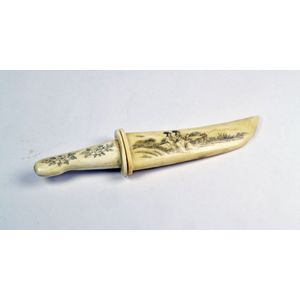Silver gilt malachite scent bottle, late 19th century
A fine silver gilt malachite scent bottle, late 19th century, the slightly tapering square section bottle in richly figured and veined malachite with an embossed and chased collar and hinged top in the rococo manner, with the original glass stopper, unmarked. Length 7 cm
You must be a subscriber, and be logged in to view price and dealer details.
Subscribe Now to view actual auction price for this item
When you subscribe, you have the option of setting the currency in which to display prices to $Au, $US, $NZ or Stg.
This item has been sold, and the description, image and price are for reference purposes only.
- Malachite - Malachite is bright copper-green coloured stone with concentric layers which displays distinct contrasting veinings. It has been valued in the past for making or decorating small precious objects such as clocks, jewellery, dishes and so. In the Orient it was used for snuff bottles and in Russia and was favoured by the Faberge workshop. larger pieces were used for table tops.
The principal source of supply was Russia but it is to be found in other regions such as Southern Africa, Mexico, Australia and France.
Malachite glass is a manufactured material that was intended to resemble malachite, but often bears more resemblance to a veined coloured marble due to its lower gloss finish and lack of concentric layers. Malachite glass was manufactured by many glassworks in the 19th century including Loetz in Austria and others in Bohemia and Davidson's Greener's and Sowerby in north eastern England.
It was particularly used for scent bottles, bowls, and small vases often decorated with nymphs.
Malachite glass has been manufactured continuously since the late nineteenth century, most is unmarked and it is difficult to distinguish the age or manufacturer of most commercial pieces. - Embossed / Repousse - Embossing, also known as repousse, is the technique of decorating metal with raised designs, by pressing or beating out the design from the reverse side of the object.It is the opposite of chasing, where the decoration is applied from the front. An embossed or repoussed object may have chasing applied to finish off the design.
This item has been included into following indexes:
- perfume / scent bottles, material
- perfume / scent bottles, period - Victorian 470
Visually similar items

A Victorian silver scent Phial, cylindrical, engraved with scrolls and with domed screw cap, David & Lionel Spiers, Birmingham 1886
Sold by
in
for
You can display prices in $Au, $US, $NZ or Stg.

Sold by
in
for
You can display prices in $Au, $US, $NZ or Stg.

Antique 9ct gold bar brooch, approx 1.8 grams total
Sold by
in
for
You can display prices in $Au, $US, $NZ or Stg.

A Japanese scrimshaw style letter opener, length 26 cm
Sold by
in
for
You can display prices in $Au, $US, $NZ or Stg.
